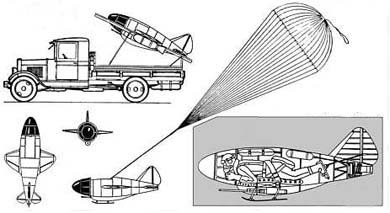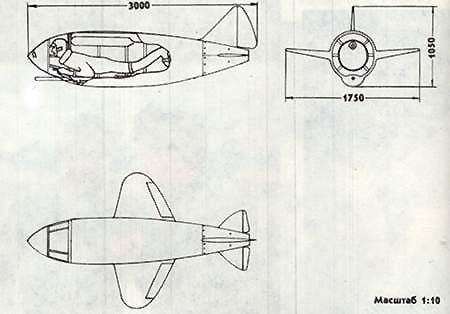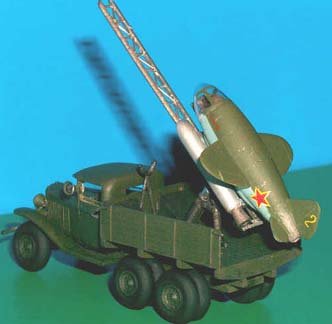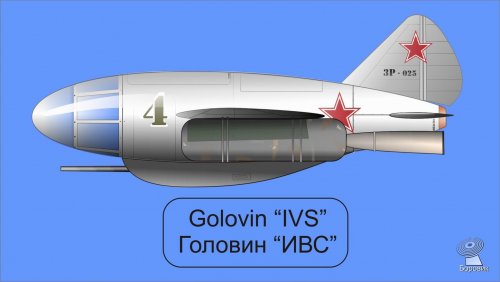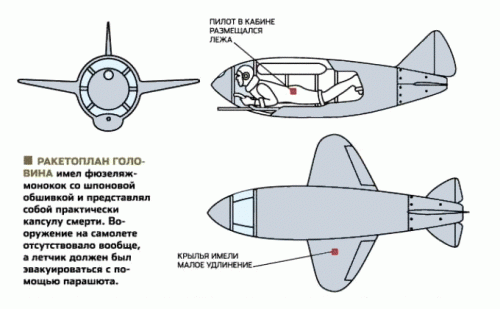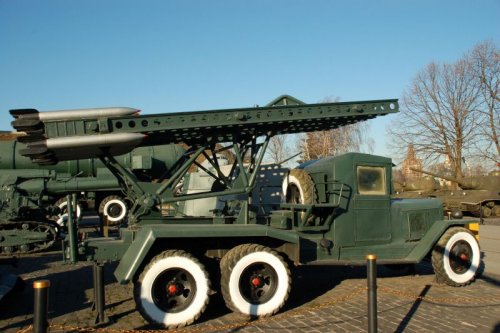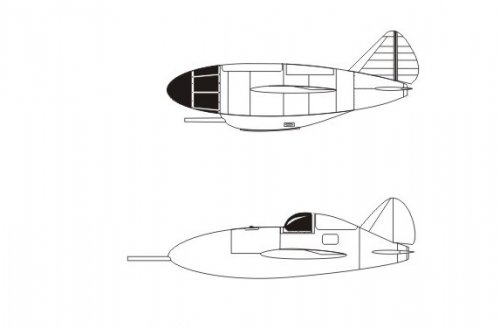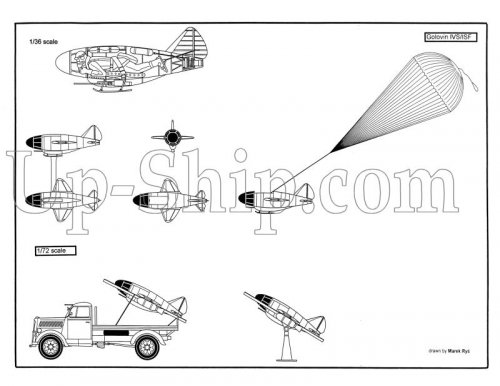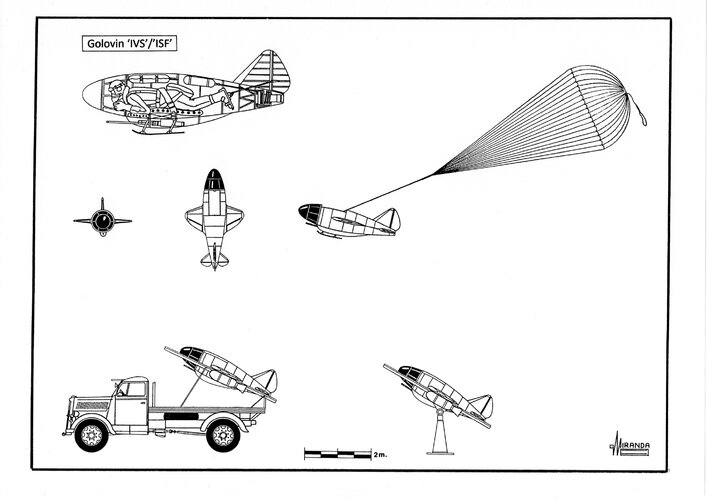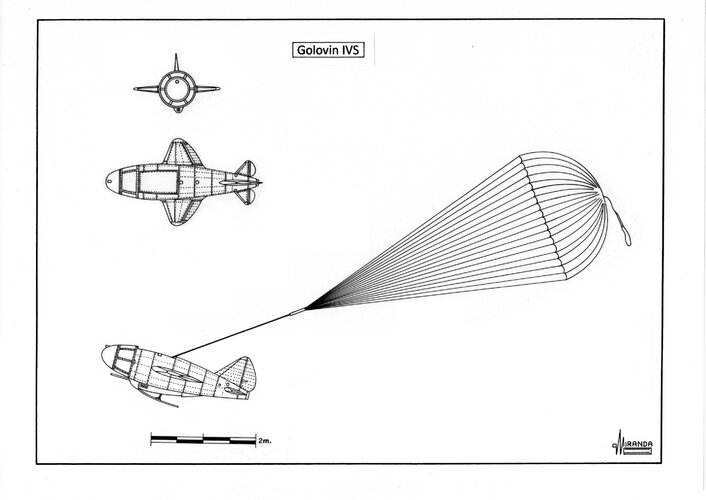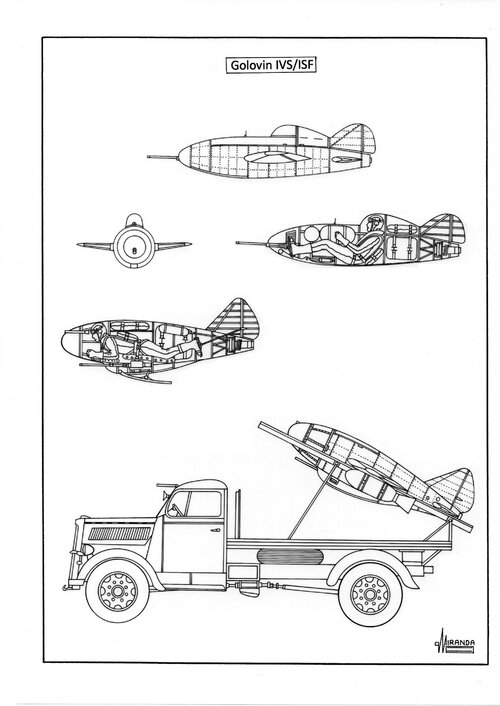You are using an out of date browser. It may not display this or other websites correctly.
You should upgrade or use an alternative browser.
You should upgrade or use an alternative browser.
Golovin IVS / ISF rocket interceptor
- Thread starter hesham
- Start date
- Joined
- 7 June 2009
- Messages
- 532
- Reaction score
- 159
Jemiba said:If my calculation is correct, the two Golovin types would have had a length of just over 3 m ! Surely would have placed them in the "ultra-ultra-light" category, even with armament, wouldn't it ? Even much shorter, than McDonnels Wobblin Goblin XF-85 ! Are there more information about those aircraft ?
Yes: 3 m length, 1.75 m wingspan, about 270 kg takeoff weight!
In late 1941, Lev Golovin, an artificer officer of 3rd rank working that time at aircraft repair shop, proposed the first version of IVS project. “IVS” meant Istrebitel Voyskovogo Soprovozhdeniya – army support fighter. This extremely small aircraft didn’t need airfields; it would start from mobile launcher based on truck chassis, and land using a parachute. The pilot was placed in prone position. This first version even wasn’t armed with traditional weapon: Golovin planned to strike enemy aircraft by ramming!
Such a radical project didn’t get a support. Therefore Golovin revised it into more conventional form. The new version was armed with one 20-mm ShVAK cannon (20 rds. ammunition load), and the pilot was now in “normal” sitting position. Golovin worked on this project (together with Eng. Lazarev) until 1944. But even this version wasn’t realized: the commission of experts decided that, although the project is realizable, it would have limited operational altitude (5500 to 7500 m) and antiaircraft artillery is more effective on these altitudes.
The IVS had wooden construction. The first version was powered by solid-fuel rocket engine; the second version used solid rocket as a start booster (1000 kg thrust), while sustainer engine was more “conventional” Dushkin liquid bipropellant rocket engine (300 kg thrust). The launcher's guide rails were 5 to 8 m long; they could rotate about vertical and horizontal axes, providing preliminary targeting. The launcher also carried store of fuel, start boosters and ammunition for 4-5 flights, replacement parachutes, a compressor or reserve of high pressure gas, and a device for IVS setting onto the guide rails. The full crew would consist of 3 persons: launcher driver, mechanic, and pilot himself. After alarm signal, the pilot would take up his place in IVS cockpit, and the mechanic would set the guide rails into starting position (about 40 degrees to horizontal). When enemy aircraft appear, the mechanic would target the IVS in their direction as precisely as possible, the pilot would start both engines from automobile power sources and fly up. After 5-6 seconds the speed would be 200-250 m/s (720 to 900 km/h); start booster jettisoned, IVS approached with the target and performed an attack. With its diminutive size and high speed, IVS would be a very difficult target for enemy gunners; this allowed it to approach with enemy on short distances making the fire more effective. If the attack would be unsuccessful, fuel capacity allowed to make second attempt. Then, after the fuel was burned out, the pilot would glide in direction of his base. At 300 m altitude he deployed landing parachute and landed the whole aircraft on it. Then the launcher would approach to the place when IVS landed, the mechanic would put the fighter back on the guide rails and prepare it for the next start.
IVS could be also used as parasite fighter, launching from heavy aircraft. In this case, it could reach 15 km altitudes. Ship-based IVS version was also projected; it was called ISF (Istrebitel Soprovozhdeniya Flota – navy support fighter).
Later, in 1958-1961, Golovin headed the OKB-464 in Dolgoprudny working on anti-aircraft and anti-missile missiles. Then he headed Department 12 in the legendary “space” NII-88 (today TsNIIMash); in particular, he worked on the program of fly-around the Moon (Soyuz-7K piloted spaceship, 9K pilotless boost vehicle, 11K pilotless tanker ship).
Technical data for the IVS (calculated):
Wing span - 1.75 m
Length - 3.0 m
Wing area - 1 m2 (!)
Takeoff weight - 250 to 300 kg
Fuel weight - 50 kg (kerosene + nitric acid)
Maximum speed - 1060 km/h
Vertical speed - 250 m/s (270 by another source)
Sources:
http://www.epizodsspace.narod.ru/bibl/stati/ivs-ivf.html
http://vtol.boom.ru/rus/ivs/index.html
Attachments
- Joined
- 9 October 2009
- Messages
- 21,973
- Reaction score
- 13,630
Somewhat similar in concept to NATO's ZEL (Zero Length Launch) experiments of the 1950's. The Soviets also came back to this concept with MiG's SM-30.
http://www.vectorsite.net/avzel.html
http://www.vectorsite.net/avzel.html
- Joined
- 25 June 2009
- Messages
- 14,753
- Reaction score
- 6,147
From the Russian edition of Popular Mechanics, February 2010:
The Golovin rocket glider had a monocoque fuselage made of veneer paneling and was virtually a death capsule. Armament on the aircraft was lacking, and the pilot had to be evacuated with the help of a parachute.
(the pilot was in lying position inside the cockpit)
(small aspect ratio wings)
Attachments
- Joined
- 11 March 2006
- Messages
- 8,625
- Reaction score
- 3,805
Comparing this internal arrangement with, say, the Me 163 or the Bachem Ba 349, I'm somewhat missing
adeqate room for fuel. The rocket engine needs room on its own, so, where is the fuel stowed ? Maybe in
the tiny wings, but that would hardly be enough, I think.
adeqate room for fuel. The rocket engine needs room on its own, so, where is the fuel stowed ? Maybe in
the tiny wings, but that would hardly be enough, I think.
avion ancien
The accidental peasant!
- Joined
- 6 March 2013
- Messages
- 371
- Reaction score
- 253
Can anyone tell me what might have been - or speculate intelligently as to - the reaction of the launch truck when the rocket engine was fired and the aircraft was launched?
- Joined
- 11 March 2006
- Messages
- 8,625
- Reaction score
- 3,805
I think, you are referring to the model ? Well, the wooden parts may looked somewhat damaged after
launch, I think, but the drawing shows it without wooden side panels. Maybe foldable pillars, as used
on mobile cranes would have been useful to prevent it from tipping over.
launch, I think, but the drawing shows it without wooden side panels. Maybe foldable pillars, as used
on mobile cranes would have been useful to prevent it from tipping over.
avion ancien
The accidental peasant!
- Joined
- 6 March 2013
- Messages
- 371
- Reaction score
- 253
The model and the first drawing. Neither seemed to suggest a launch platform sufficiently stable to permit a safe and accurate launch of a rocket powered aircraft. However maybe with the addition of 'outriggers' (such as those seen on mobile cranes) the potential problem could be ameliorated. But did this concept exist in 1941/2? If not, then maybe even if the aircraft would have been reuseable, perhaps it would not have been the same for the launch truck!
- Joined
- 11 March 2006
- Messages
- 8,625
- Reaction score
- 3,805
The nearest I've found to this launch truck is the wellknown Katyusha rocket launcher mounted on a truck.
The drawing of the Golovin IVS shows another model, but I suspect, there aren't original drawings and
that one is just a supposition.
As redstar wrote "The launcher also carried store of fuel, start boosters and ammunition for 4-5 flights,
replacement parachutes, a compressor or reserve of high pressure gas, and a device for IVS setting onto
the guide rails." all that equipment would be hard to integrate on such a truck either !
The drawing of the Golovin IVS shows another model, but I suspect, there aren't original drawings and
that one is just a supposition.
As redstar wrote "The launcher also carried store of fuel, start boosters and ammunition for 4-5 flights,
replacement parachutes, a compressor or reserve of high pressure gas, and a device for IVS setting onto
the guide rails." all that equipment would be hard to integrate on such a truck either !
Attachments
lippischh
ACCESS: Secret
Just to notify people that doesnt know, you can find my artwork related to this aircraft here : http://www.secretprojects.co.uk/forum/index.php/topic,18552.0.html
Now, i have two questions : 1- is the sat pilot version is it the same model with some added parts (variant) or is it a whole different shape?
2- in the 3view shown by Stargazer from the Russian edition of Popular Mechanics, am i wrong to say the front is blind and has just a little hole to see through, note that this feature isnt present in other drawings nor scale models.
Cheers
Now, i have two questions : 1- is the sat pilot version is it the same model with some added parts (variant) or is it a whole different shape?
2- in the 3view shown by Stargazer from the Russian edition of Popular Mechanics, am i wrong to say the front is blind and has just a little hole to see through, note that this feature isnt present in other drawings nor scale models.
Cheers
- Joined
- 11 March 2006
- Messages
- 8,625
- Reaction score
- 3,805
My interpretation about whole in the nose: The solid part is used as armour for the pilot, the aperture
is just used for gun aiming. By raising his head, or maybe adjusting his lounger, the pilot could get a
better view for landing.
is just used for gun aiming. By raising his head, or maybe adjusting his lounger, the pilot could get a
better view for landing.
- Joined
- 28 January 2008
- Messages
- 635
- Reaction score
- 511
A bit more information on this type to supplement RedStar72's detailed description posted above.
DESIGNATION: Golovin IVS (ISF)
DESCRIPTION: Experimental Rocket Fighter
The IVS was designed by Lev Golvin. It was one of the most radical rocket aeroplane designs. IVS/ISF denoted "Army Following Fighter" or "Navy Shadowing Fighter". Golvin was a military engineer. The IVS was among the worlds smallest fighters and was designed as part of a mobile launcher complex comprising of a truck carrier, 5-8 m long launcher, fuel and ammunition stock with a winch and the aeroplane itself.
It comprised of a pilot, mechanic and a driver for the entire package. The idea was for the system to provide ships and troops with air cover demanding no special airfields to operate from. The pilot occupied a prone position that reduced the G-loading and enabled a rapid rate of climb.
The single Duchkin liquid fuelled rocket motor was assisted at take-off by a solid fuel rocket booster with an additional 1,000 kg static thrust.
The landing equipment consisted of a 76 sq m parachute and a belly skid, which was removed for the navalised version. The entire project was offered for mass production but the VVS authority rejected the idea of a mobile small interceptor in favour of dedicated anti-aircraft artillery.
DETAILED SPECIFICATION:
ENGINE: 1 x Dushkin Liquid Fuel Rocket (300 kg thrust)
WING SPAN: 1.75 m
LENGTH: 3.00 m
HEIGHT: 1.05 m
ACCOMODATION: 1 crew
MAXIMUM SPEED: 1,060 km/h
SERVICE CEILING: 7,500 m
FIRST FLIGHT: 1941
RATE OF CLIMB: 250 m per second
ARMAMENT: 1 x 20mm ShVAK cannon
SOURCES:
Alexandre Savine WWW Pages 1997
Krilya Rodiny (no date)
Russian Aviation Research Group Bulletin No 146
DESIGNATION: Golovin IVS (ISF)
DESCRIPTION: Experimental Rocket Fighter
The IVS was designed by Lev Golvin. It was one of the most radical rocket aeroplane designs. IVS/ISF denoted "Army Following Fighter" or "Navy Shadowing Fighter". Golvin was a military engineer. The IVS was among the worlds smallest fighters and was designed as part of a mobile launcher complex comprising of a truck carrier, 5-8 m long launcher, fuel and ammunition stock with a winch and the aeroplane itself.
It comprised of a pilot, mechanic and a driver for the entire package. The idea was for the system to provide ships and troops with air cover demanding no special airfields to operate from. The pilot occupied a prone position that reduced the G-loading and enabled a rapid rate of climb.
The single Duchkin liquid fuelled rocket motor was assisted at take-off by a solid fuel rocket booster with an additional 1,000 kg static thrust.
The landing equipment consisted of a 76 sq m parachute and a belly skid, which was removed for the navalised version. The entire project was offered for mass production but the VVS authority rejected the idea of a mobile small interceptor in favour of dedicated anti-aircraft artillery.
DETAILED SPECIFICATION:
ENGINE: 1 x Dushkin Liquid Fuel Rocket (300 kg thrust)
WING SPAN: 1.75 m
LENGTH: 3.00 m
HEIGHT: 1.05 m
ACCOMODATION: 1 crew
MAXIMUM SPEED: 1,060 km/h
SERVICE CEILING: 7,500 m
FIRST FLIGHT: 1941
RATE OF CLIMB: 250 m per second
ARMAMENT: 1 x 20mm ShVAK cannon
SOURCES:
Alexandre Savine WWW Pages 1997
Krilya Rodiny (no date)
Russian Aviation Research Group Bulletin No 146
- Joined
- 9 October 2009
- Messages
- 21,973
- Reaction score
- 13,630
With regards as to the SM-30:

 elpoderdelasgalaxias.wordpress.com
elpoderdelasgalaxias.wordpress.com

Mikoyan SM-30: Выше и Вперёд !!
The Soviets couldn’t be less bold than the Americans. Their “ZEL” system utilized the SM-30 (an experimental MiG-19 model) boosted by a PRD-22R solid fueled rocket. Contrary to th…
Similar threads
-
“The Ultimate Allied Fighters of the Second World War” by Justo Miranda
- Started by Justo Miranda
- Replies: 40
-
-
New Fonthill Book - Rocket Interceptors 1941-1947
- Started by Justo Miranda
- Replies: 2
-
Justo Miranda's "Unknown!" series, #1, #2 now available
- Started by Orionblamblam
- Replies: 3
-


